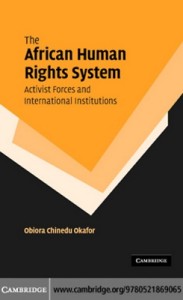|
Reviewed by Benjamin Arah, Ph.D., Assistant Professor of Government & Philosophy, Bowie State University This is a fascinating and interestingly important book for political scientists, African scholars and international human rights practitioners, because Professor Okafor endeavored to bring to light the various approaches that are used in the field of international human rights systems with a particular emphasis on quasi-constructivism. As the title of the book suggests, there are three key concepts the author carefully knotted to help him focus on and deal with the complex questions raised in Chapter One that underlie the direction of the book. The book is divided into eight chapters, with one as “An Introduction” (pp. 1-11) and eight as a summative and thought-provoking “Conclusion” (pp. 296-301). Professor Okafor noted the importance of the concepts (African human rights system, activist forces, international human rights institutions or IHIs, and trans-judicial communication) that they were “central to the questions raised” and relevant to the overall objectives of the book. The author deliberately used the “African human rights system” to refer to the existing human rights system in the continent of Africa that was founded, as he highlighted, by the African Charter on Human Rights and Peoples’ Rights in 1981 and which came into active existence in 1987 (Okafor 2007, 1-2). By “activist forces,” as exemplified by groups particularly the activist judges and civil society actors (although the list would include other sub-groups that included the women’s groups, university students, dissidents, pro-democracy groups, etc.), Professor Okafor seemed to have in mind those few groups who, unlike others, operate with civil disobedience or “resistance character” in the tradition of Socrates, Henry Thoreau, Mahatma Gandhi, Dr. Martin Luther King, Jr., and Nelson Mandela. The “activist forces” were those people who, with their unique disposition and non-cooperative civil protest strategies, have “openly challenged and challenge aspects of dictatorial rule and continue to fight to ameliorate human rights violation in countries” (Okafor 2007, 2) in countries known for their human rights violations as Nigeria, South Africa, Togo, Benin, Ghana, and Namibia. And with reference to the third concept, was the “international human rights institutions” which are “both international human rights regimes and the bodies and mechanisms that monitor actor’s adhesion to regime norms and goals” (Okafor 2007, 3). Some of these international institutions included the Human Rights Committee, the Committee against Torture, and the African Commission on Human and Peoples’ Rights inherent in the African Charter. Professor Okafor was particular in his choice of “trans-judicial communication” which, as he would have it, is about the brokered transnational transmission and shared communication of certain international norms, values, ideas and knowledge between the African international human rights system and the local institutions of the participating bodies. He argues that the activist forces, as facilitators of the brokered transnational transmission and communication, played a great role in the effort to bring theory into praxis. The author listed the two objectives for writing the book as follows: · Argues for a modest extension of the measure through the assessment of the effectiveness of the African system. In view of these objectives, Professor Okafor did an excellent analysis using the case study approach, designed to encourage African scholars and human rights practitioners to do more; and had “gathered relevant evidence from Nigeria, South Africa, and a number of other African countries in order to ground the broader effort that is undertaken” (Okafor 2007, 5). Agreeably, the book appears to be an ethnographic case study undertaken to broaden and sharpen our understanding of international law, international institutions, and the study of international relations from the local perspective. In this regard, Professor Okafor would acknowledge that the study suggests, reference to Balakrishnan Rajagopal (2003), the importance of working at the grassroots level with a focus on being able to filter and tease out the ways in which local agents deploy and make use of IHIs as resources in their own human rights struggles (Okafor 2007, 298). I enjoyed reading the book because of its dynamic nature and interdisciplinary approach that highlights the impact of local actors on the African human rights system. The author was ambitious in writing this detailed and interpretive critical study case book. With specific examples, and based on the constructivist bent, it enriches our understanding of both the African human rights system and the international human rights institutions. |


 The African Human Rights System, Activist Forces and the International Institutions
The African Human Rights System, Activist Forces and the International Institutions